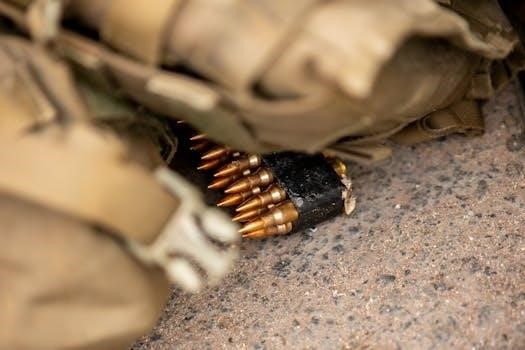Overview of the War Scroll (1QM)
The War Scroll, also known as 1QM, is unique. Its genre presents a vision of an eschatological war. PDF versions and online resources offer access. Translations provide deeper insight.
Significance as a Dead Sea Scroll
The War Scroll (1QM) holds immense significance as a Dead Sea Scroll, offering a unique glimpse into Jewish eschatological beliefs around the time of Jesus. Its detailed account of a final battle, available in PDF form for study, provides insights into the community’s worldview. The text outlines a conflict between the Sons of Light and Darkness, reflecting theological and tactical frameworks.
Access to PDF downloads and online resources facilitates research. Scholars can easily examine published translations and commentaries to understand its place among the Dead Sea Scrolls. The scroll’s vivid descriptions contribute to our understanding of Second Temple Judaism.
The availability of the War Scroll in PDF format ensures continued exploration of its historical and religious importance. It is invaluable for researchers examining Jewish thought during a pivotal period.
Central Theme⁚ Eschatological War
The central theme of the War Scroll (1QM) revolves around an eschatological war. This war is portrayed as a final, decisive battle between the forces of good and evil. This vision is available for review in various PDF formats. The Sons of Light clash with the Sons of Darkness in a conflict. It is orchestrated by Belial.
This theme reflects a key aspect of Jewish thought during the Second Temple period. Accessing PDF versions of the War Scroll allows detailed analysis of its descriptions. The scroll’s vivid imagery provides insight into the community’s beliefs about the end times.
The war is not merely a physical battle. It also represents a spiritual struggle. The availability of translations, online resources, and PDF downloads, makes studying this crucial text easier. Ultimately, the theme underscores the hope for divine intervention and the triumph of righteousness.

Content and Structure
The War Scroll outlines a conflict. It is between the Sons of Light and Darkness. It details stages, tactics, and military organization. These elements offer insight into the war’s framework, which are in the PDF.
The Sons of Light vs. Sons of Darkness
The War Scroll, accessible in PDF format, vividly portrays a cosmic battle. It is between the Sons of Light and the Sons of Darkness. This central conflict defines the scroll’s narrative and theological framework. The Sons of Light, representing the Yahad community, are pitted against the forces of Belial.
The Sons of Darkness include various groups. They are Edom, Moab, Ammon, Amalekites, Philistia, and the Kittim of Asshur. These forces are led by the supernatural figure Belial. This is a stark contrast between good and evil.
The scroll details the initial attack. It is by the Sons of Light against the Sons of Darkness. This conflict involves those who violated the covenant. The PDF provides insights into the ideological war.
Stages of the Conflict
The War Scroll, available for PDF download, outlines a multi-stage conflict. It is between the Sons of Light and the Sons of Darkness. The initial stage involves the Sons of Light attacking the forces of Belial. This includes Edom, Moab, Ammon, Amalekites, Philistia, and the Kittim of Asshur.
Later stages detail the return of the Sons of Levi from the Wilderness of the Peoples. They camp in the Wilderness of Jerusalem. These stages are essential for understanding the scroll’s eschatological vision.

The scroll describes a three-stage conflict. The first attack is undertaken against the Sons of Darkness. The PDF versions allow for close examination of these stages. Each stage involves specific tactical maneuvers and divine intervention. The final stages lead to the ultimate triumph of the Sons of Light.
Tactical Framework and Military Organization
The War Scroll, accessible via PDF, details a structured tactical framework. It is for the eschatological war. The military organization is hierarchical. It emphasizes precise formations and strategic deployments. The scroll outlines specific roles for priests, Levites, and soldiers. They have designated positions within the army.
The tactical framework includes detailed instructions for battle formations. These formations are the deployment of weapons, and communication signals. The army is divided into units based on tribal affiliations. Each unit has its banner and designated leader. PDF versions of the War Scroll reveal the meticulous planning involved.
The text emphasizes the importance of divine guidance and ritual purity. This ensures success in battle. The tactical strategies described reflect contemporary military practices. The PDF provides insights into the beliefs about warfare during the Second Temple period. The military organization is designed to maximize efficiency and coordination.

Interpretations and Historical Context
Interpretations of the War Scroll, often found in PDF form, vary widely. Some scholars see historical connections. Others emphasize its theological significance within its historical context.
Identification of the Kittim
One of the key interpretive challenges regarding the War Scroll, accessible in various PDF versions, revolves around the identification of the Kittim. The scroll describes them as a major enemy force. Scholars have proposed several identifications. Some believe the Kittim were the Romans, given Rome’s dominance during the time of the scroll’s writing.
Others suggest the Greeks under Alexander the Great or his successors. The term “Kittim” itself is somewhat ambiguous. It could refer to a more general designation for maritime powers or invaders from the Mediterranean region. Deciphering their identity is crucial for understanding the scroll’s historical and political context.
Identifying the Kittim is essential. It helps to situate the War Scroll within a specific historical timeframe and socio-political landscape. This allows for a more nuanced reading.
Possible Roman Connection
The interpretation of the Kittim in the War Scroll, often available in PDF format, as potentially representing the Romans is a significant area of scholarly debate. The scroll’s descriptions of the Kittim’s military prowess, their far-reaching influence, and their perceived threat to the Jewish people align with the historical reality of Roman expansion in the region during the first century BCE and CE.
The Romans’ military tactics and political control resonate with the scroll’s depiction of the Kittim’s dominion. Furthermore, the scroll’s apocalyptic tone and anticipation of a final battle against evil forces could be linked to the Jewish resistance movements against Roman rule.
While the identification isn’t definitive, the evidence suggests that the Roman Empire may have served as a key point of reference. This helps contextualize the scroll’s depiction of the ultimate eschatological conflict.

Availability and Access
The War Scroll (1QM) is accessible through PDF downloads and online resources. Published translations and commentaries offer further insights. These resources provide valuable access to this significant Dead Sea Scroll.
PDF Downloads and Online Resources
Accessing the War Scroll (1QM) in digital format has become increasingly convenient with the proliferation of PDF downloads and online resources. Several websites and online libraries offer the War Scroll in PDF format, allowing researchers and enthusiasts to study the text without needing physical access to the original fragments. These PDFs often include high-resolution images of the scroll fragments, transcriptions of the Hebrew text, and English translations.
Numerous online resources provide valuable context and analysis of the War Scroll. Websites dedicated to Dead Sea Scrolls research often feature articles, essays, and interactive tools that enhance understanding of the scroll’s historical and theological significance. Some resources also offer virtual tours of the Qumran site where the scrolls were discovered, providing a visual context for the War Scroll’s origins. These digital resources democratize access to the War Scroll, making it available to a global audience.
Published Translations and Commentaries
Numerous published translations and commentaries offer in-depth analyses of the War Scroll (1QM). These scholarly works provide crucial insights into the scroll’s linguistic nuances, historical context, and theological significance. Renowned Dead Sea Scrolls experts have produced translations that aim to accurately convey the original Hebrew text into modern languages, making the War Scroll accessible to a wider audience.
Commentaries delve into the scroll’s complex themes, exploring its portrayal of an eschatological war between the Sons of Light and the Sons of Darkness. These publications often include detailed notes on specific passages, offering interpretations of key terms, military tactics, and the identities of the Kittim. Furthermore, many commentaries examine the War Scroll’s relationship to other Dead Sea Scrolls and its broader place within Second Temple Judaism; Scholars often consult multiple translations and commentaries to gain a comprehensive understanding of this important text.
